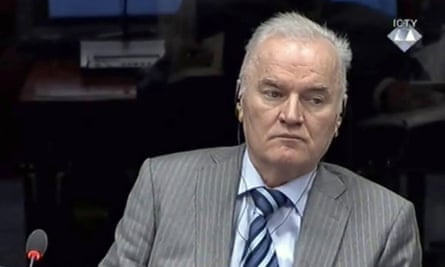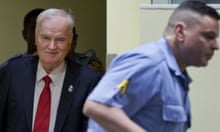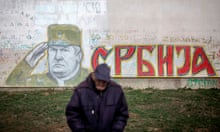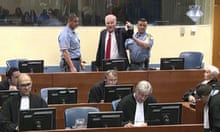Ratko Mladić had vowed never to succumb to the humiliation he suffered on Wednesday morning, of being judged by a foreign court. He told his officers he would not be taken alive and carried a duffel bag of guns through all his years on the run to ensure he would be as good as his word.
When the critical moment came however, the man who ordered many thousands of deaths could not bring himself to take his own. On 26 May 2011, when plainclothes officers from the Serbian interior ministry turned up at his final hiding place – a room in his cousin’s house in a remote northern village – the old general, enfeebled by two strokes and a heart attack, left his Heckler & Koch machine gun where he had stashed it, among his socks at the bottom of a cupboard.
“I suppose people will ask why I didn’t kill myself,” he grumbled to one of his supporters weeks later in jail. “But I was not psychologically able to, and I didn’t want them to say we are family of suicides.”
Some 17 years earlier, in February 1994, when the Bosnian conflict was mired in a bloody stalemate, Mladić’s daughter, Ana, used his favourite pistol to shoot herself. She was in love with a doctor, who was appalled at the slaughter in Bosnia being committed in the name of the Serb nation. He would only marry her if she renounced her father. She resolved the dilemma by removing herself.
Mladić never accepted that his own actions had anything to do with Ana’s death. Instead, he invented conspiracy theories which projected the blame outwards, on the historical enemies of the Serbs. His thirst for revenge redoubled. In a lifetime surrounded by death, Ana’s was one of the very few that mattered to him.
Mladić was born into conflict. His name can be translated as “warlike youth”. His father, a partisan, was killed in battle in 1945, when he was two. His mother, Stana, raised three children on her own.
As a teenager, Ratko had a go at being a tinsmith’s apprentice before giving it up and dedicating his life to the Yugoslav national army. At the end of it all, after fighting in Croatia to keep a Serb-run Yugoslavia together and losing, and then fighting for a Serb-dominated Bosnia, and losing again after the death of 100,000 people, Mladić spent 14 years as a fugitive before finally losing that battle too.

“You have found who you’re looking for,” he told the officers from the war crimes unit who had come to find him. Mladić sat in a rumpled black peaked cap in the back of the car on the drive south back to Belgrade. Once there, he had two requests for the judge. He wanted to go to his mother’s grave in Bosnia, and to Ana’s grave in Belgrade. The judge granted the second request. While government officials stood waiting to fly him to The Hague, he stood before her gravestone mumbling words to his daughter.
In his six years in detention in the seafront Hague suburb of Scheveningen, and through his more than 500 days in court at the international criminal tribunal for the former Yugoslavia, Mladić has portrayed himself as a victim of foreign conspiracies to do down the Serb people. It is this cult of victimhood that powered his brand of aggressive nationalism. It proved a rocket fuel for sadism.
He repeatedly portrayed his “ethnic cleansing” campaign in Bosnia, targeted overwhelmingly against Muslim Bosniaks, as revenge for the Ottoman empire. In July 1995, when he strode with his military aides into Srebrenica, which had supposedly been a “safe haven” under UN protection which failed to materialise, he declared his “victory” as vengeance for an ancient massacre of Serbs at the hands of “the Turks”. He was filmed patting eight-year-old Izudin Alić on the head, handing the hungry Bosniak boy a chocolate bar and assuring the people of Srebrenica they would be safe. Within a few days, the boy’s father would be tracked down and killed by Mladić’s troops, along with more than 7,000 Bosniak men and teenage boys.
For more than seven years, long after the bones of the dead had been dug out of mass graves, and the crimes of Mladić’s army had been laid out for the world to witness, Serbia’s army looked after him in the name of ethnic solidarity in the face of a hostile world.
The fragile fiction in Bosnia, as in eastern Ukraine today, was that Bosnian Serb forces were freedom fighters thirsting for their independence. In fact, they operated with the guidance and support of a stronger neighbour, Slobodan Milošević’s regime in Belgrade.
Mladić and other Bosnian Serb officers were paid by the 30th Personnel Centre of the Yugoslav army, run from Belgrade. And when Nato peacekeepers and western intelligence agencies operating in Bosnia began to get serious about tracking down war crimes suspects in 1997, Mladić was sheltered and catered for in army recreation compounds across Serbia.
“The Serbian government and army were clearly protecting Mladić,” said John Sipher, a former CIA officer who took part in the hunt for war crimes suspects when he was stationed in the Balkans.

“I remember Montenegrins telling us about trips he made down there to see old friends in the military. He was clearly being protected and felt comfortable living in Serbia.”
The CIA was aware Mladić spent some of his time as one of Europe’s most wanted men in his own house in a wealthy Belgrade suburb where some US embassy employees lived. There was nothing the agency could do.
After Milošević fell in 2000, the country’s new prime minister, Zoran Đinđić, offered the US and the UK the option of going to grab Mladić with their own troops. But Đinđić did not control the army, and the allies declined the offer rather than risk a gunfight on the strength of an uncertain tip-off from a precariously positioned politician. Đinđić himself was assassinated in 2003.
TimelineRatko Mladić: the long road to justice
Show
The breakup of the former Yugoslavia formally begins when Slovenia and Croatia declare independence. The Serb-led Yugoslav army withdraws from Slovenia after a 10-day conflict, but the war in Croatia that followed would last until 1995.
Bosnian Serbs swiftly take control of more than two-thirds of Bosnia and launch the siege of Sarajevo, headed by Ratko Mladić, who becomes the Bosnian Serb army commander a month later. The siege lasts 1,460 days, during which more than 11,500 people die.
Mladić's troops capture Srebrenica, where more than 8,000 Muslim men and boys were killed. Nato bombs Bosnian Serb positions following reports of the slaughter.
The international criminal tribunal for the former Yugoslavia indicts Mladić and Bosnian-Serb leader Radovan Karadžić on charges including genocide.
The Dayton agreement is signed, ending the war and creating two mini-states in Bosnia: a Bosnian-Serb one and a Muslim-Croat one.
Nato peacekeepers and western intelligence agencies operating in Bosnia step up attempts to track down war crimes suspects, but Mladić is sheltered by loyalists in Serbia. He is seen attending football games and eating at Belgrade restaurants.
Following intense pressure from the international community on Serbia, Mladić is arrested in Serbia.
He appears in court at the UN tribunal for the first time in June but refuses to enter pleas to the charges against him. At a second hearing in July, judges enter not guilty pleas on his behalf.
The trial in The Hague is arguably the most significant war crimes case in Europe since the Nuremberg tribunal, in part because of the scale of the atrocities involved. Over 530 days, the UN tribunal hears from 591 witnesses and examines nearly 10,000 exhibits concerning 106 separate crimes.
During closing statements, prosecutors urge judges to convict Mladić on all counts and sentence him to life in prison. Defence attorneys call for acquittal.
More than 20 years after the Srebrenica massacre, the now 74-year-old Mladić is sentenced to life imprisonment after being convicted of genocide, war crimes and crimes against humanity.
Delivering the verdicts, the judge said Mladić’s crimes “rank among the most heinous known to humankind and include genocide and extermination”.
Eventually, even the army had to bow to control from elected civilian governments, and Mladić was forced to rely on an ever dwindling circle of loyalists. He took refuge in anonymous apartments and rural family plots. Even then however, he stayed beyond his enemies’ reach.
“If you got a report that Mladić was at some place near the border where it might even be possible to go in, we had no sources that we had tested over a long time, so it would have been a complete gamble,” Sipher recalled.

In the end, Mladić was handed over by his fellow Serbs, weary of sanctions and isolation. But even with the culmination of his five-year trial and his conviction, the triumph of international justice over impunity is far from complete.
Nationalism is very much back in the saddle in Serbia and the Bosnian Serb republic, along with blanket denial of war crimes. The Serbian government announced last month that a convicted war criminal, Vladimir Lazarević, released from jail in 2005 after serving two-thirds of his sentence, would be lecturing at the country’s military academy.
One of the investigators in The Hague tribunal’s tracking team, which played a coordinating role in the hunt for Balkan war criminals, said he took a nostalgic motorcycle tour through Bosnia this summer and decided to make a detour to Mladić’s birthplace in the Serb-run municipality of Kalinovik. As he got off his bike, he was greeted by a two-word message spray-painted on a wall: “Mladić – Hero.”
Julian Borger is the Guardian’s world affairs editor. His book on the pursuit and capture of the Balkan war criminals, The Butcher’s Trail, is published by Other Press.







